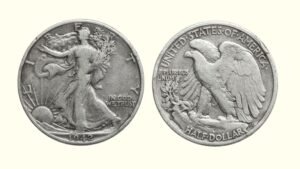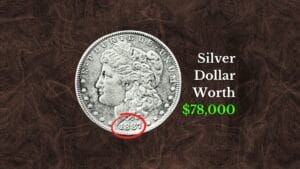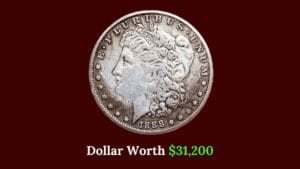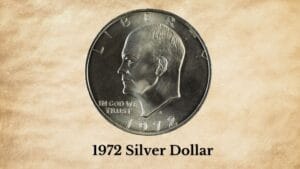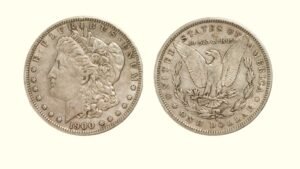If you have an old 1896 silver dollar in your collection, you just got rich! The 1896 Morgan Silver Dollar featuring the Lady Liberty on the obverse and flying eagle on the reverse, stands as one of the most valuable coins in American numismatics, with its finest specimen selling for a whopping $720,000!
Could your 1896 dollar be a hidden gem and bring such a big fortune? Find out in this guide to identifying rare features, like unique mint marks, proof strikes, and minting errors!
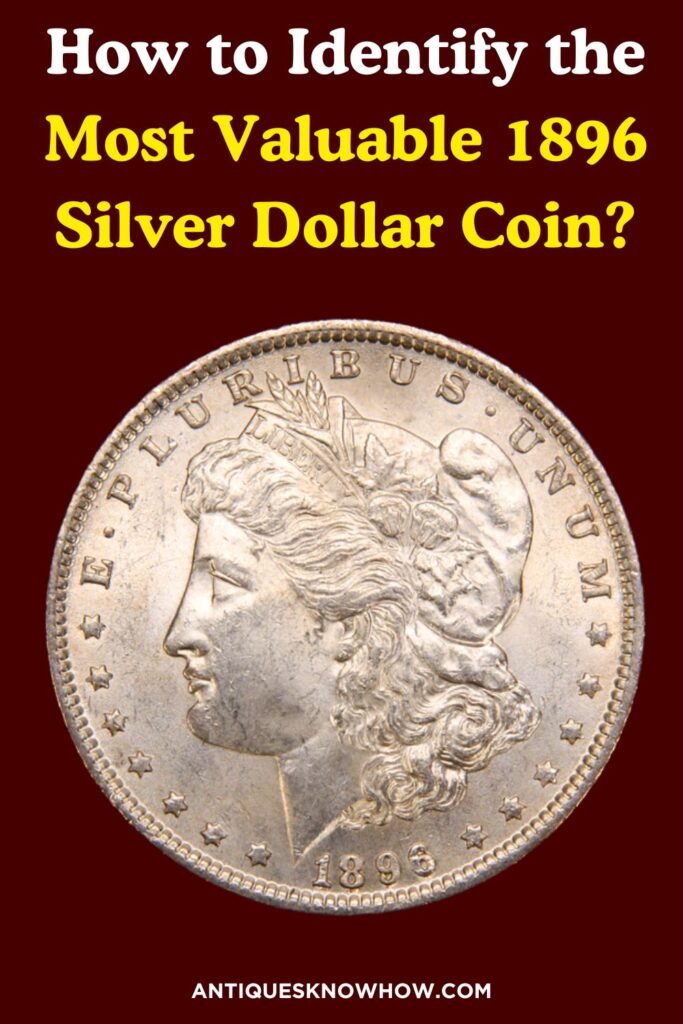
Interesting History of 1896 Morgan Dollar
The Morgan Silver Dollar, designed by George T. Morgan, entered its 18th year of production in 1896. This particular year saw the production of Morgan dollars at four three mints: Philadelphia, New Orleans, and San Francisco facility.
The 1896 issue came during a time when the Treasury Department was still bound by the Sherman Silver Purchase Act of 1890, requiring significant silver dollar production despite growing government stockpiles.
Though all the mints produced millions of coins in total, the 1896 Morgan dollar remained a highly acclaimed coin to date. Thanks to its several errors, high-quality strike, and silver content, these coins can fetch thousands today!
| 1896 Morgan Silver Dollar | Key Facts |
| Material Composition | 90% Silver, 10% Copper |
| Minting Location | Philadelphia, New Orleans, & San Francisco |
| Year of Minting | 1896 |
| Face Value | $1.00 |
| Weight | 26.73 grams |
| Actual Silver Content | 0.7734 oz |
| Diameter | 38.1mm |
| Thickness | 2.4mm |
| Designer | George T. Morgan |
| Mint Marks | No Mint Mark – Philadelphia O – New Orleans S – San Francisco |
| Total Mintage | 19,876,762 coins |
Identifying a Real 1896 Silver Dollar (Design & Features)
Authentication of an 1896 Morgan Silver Dollar requires careful attention to design details, weight, and metallic composition. Here are the complete details:
1896 Morgan Dollar Obverse:

- A left-facing portrait of Lady Liberty with flowing hair
- A Phrygian (conical) cap on Liberty’s head
- “1896” at the bottom
- Arranged flowers and the word “LIBERTY” on the lady’s cap
- “E PLURIBUS UNUM” on the upper edge
- 13 stars (representing the thirteen US states) around the coin’s edge
1896 Morgan Dollar Reverse:
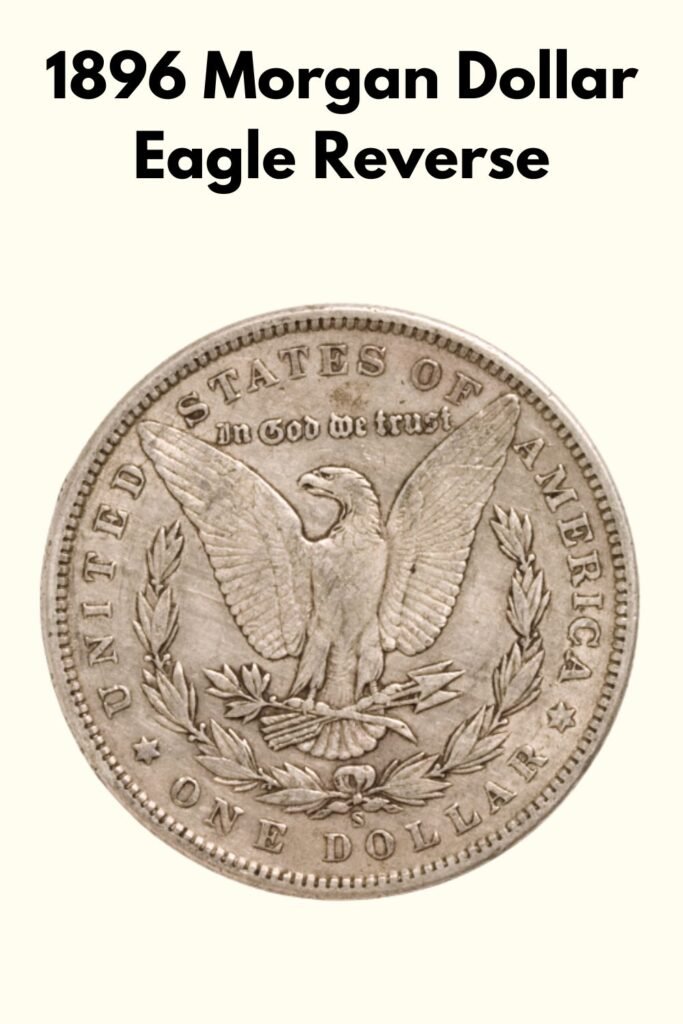
- A bald eagle mid-flight with wide wings a left-facing head
- A group of arrows in its left claw and an olive branch in the right
- “UNITED STATES OF AMERICA/ONE DOLLAR” around the rim
- “IN GOD WE TRUST” above the eagle
- A laurel vine around the eagle
- The mint mark, if present, below the laurel vine knot
Coin Composition, Weight & Size
The 1896 Morgan Silver Dollar adheres to the specifications established by the Coinage Act of 1878, featuring a composition of 90% silver and 10% copper. Each silver coin weighs exactly 26.73 grams or 412.5 grains and measures 38.1 millimeters in diameter, with a thickness of 2.4 millimeters. The edge is reeded with 178 reeds, serving both as a decorative element and an anti-counterfeiting measure.
Verify all these features and dimensions on your 1896 Morgan dollar to ensure it’s not a counterfeit. You can also perfect a magnet test (putting a magnet close to your coin) to check the composition; real silver dollars won’t react to the magnet.
Finding an 1896 Morgan Silver Dollar Value (3 Key Factors)
The value of an 1896 Morgan Silver Dollar starts at its silver content worth (approximately $20-$25 based on current silver prices) but can reach into the hundreds of thousands for high-grade specimens.
This sharp spike in the value occurs due to several features, such as the condition (coin grades), mint mark, proof examples, and rare minting errors.
1. 1896 Morgan Dollar Mint Marks & Mintage
| Coin Grades | Condition Details | 1896 No Mint Mark Dollar Value | 1896 O Morgan Dollar Value | 1896 S Silver Dollar Value |
| Poor (0) to Extremely Fine (XF45) | Significant wear, faded but visible details | $20 – $30 | $30 – $100 | $40 – $700 |
| Almost Uncirculated (AU50) to Mint State (MS60) | Slight wear on highest points, visible marks or blemishes | $30 – $50 | $130 – $1,600 | $900 – $2,000 |
| Mint State (MS61 – MS64) | Uncirculated with minimal wear | $40 – $150 | $1,700 – $33,600 | $2,500 – $7,800 |
| Mint State (MS65 – MS66+) | Nearly flawless with very minor imperfections | $160 – $600 | $70,000 – $528,000+ | $8,500 – $75,000 |
| Mint State (MS67 – MS67+) | Well-preserved with no major flaws | $1,000 – $6,500+ | N/A | $60,000 – $120,000 |
| Mint State (MS68 -MS69) | Nearly perfect, luster, no major marks or flaws | $8,000 – $30,000+ | N/A | $130,000 – $720,000 |
The 1896 Morgan Dollar was produced at four different mints, each facility contributing its own characteristics and value to the series.
1896 No Mint Mark Silver Dollar Value (Mintage – 9,976,000)
The Philadelphia Mint, producing coins with no mint mark, led production with over 9.97 million pieces. Circulated Philadelphia 1896 no mint mark silver coin specimens in the circulated state are worth $30-50. MS65 examples typically sell for $200 to $350, while MS67 examples command $1,000 to $6,500 and MS68 pieces can reach up to $30,000!
The most expensive 1896 No mint mark Morgan dollar in MS68-grade was bought for $30,550 via Legend Rare Coin Auctions!
The Prooflike version of an 1896 no mint mark dollar can be valued at $60-$550 in MS62-MS65 grades, with MS67 and higher grades reaching up to $5,000 to $19,200. In contrast, Deep Mirror Prooflike or DMPL dollar coins fetch $3,200-$14,000 for their highest grade, MS66 and MS66+
1896 O Silver Dollar Value (Mintage – 4,900,000)
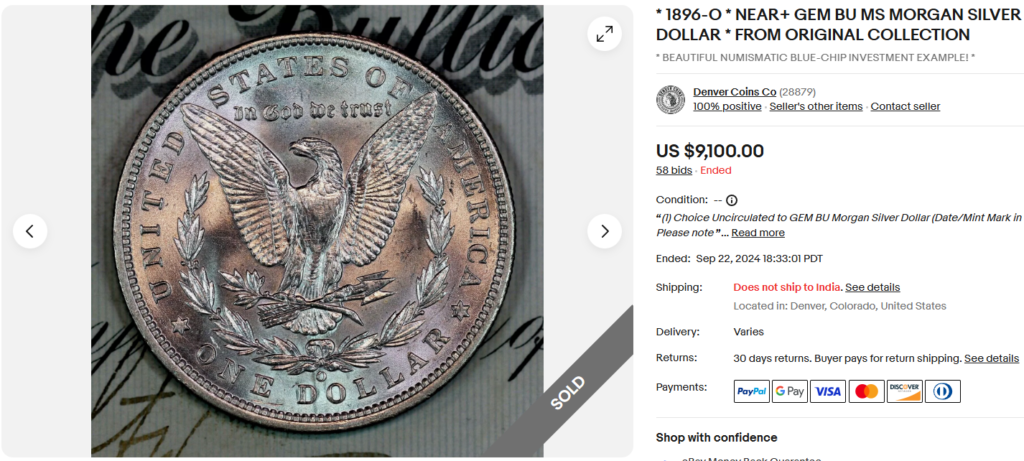
The New Orleans Mint, identified by the “O” mint mark, produced 4.9 million silver dollars in 1896. New Orleans strikes are known for generally weaker striking quality compared to other mints, making well-struck examples particularly desirable.
For example, MS65 1896 O silver dollar coins typically bring $70,000 to $150,000, with extremely rare MS-66 pieces commanding $340,000 to $520,000. The highest value released for an 1896-O silver dollar graded MS66 was $528,000 at Stack’s Bowers!
The proof-like and Deep mirror proof-like varieties of an 1896 Silver dollar can also fetch thousands in uncirculated mint state, especially high grades reaching up to $25,000!
1896 S Silver Dollar Value (Mintage – 5,000,000)

The San Francisco mint released 5 million 1896 silver dollars, identified by the “S” mint mark. Featuring a sharp striking quality and lesser production, an 1896-S silver dollar is the most valuable of all!
In circulated state only, this coin can fetch $30 to $2,250. Well-preserved MS-65 uncirculated coins generally bring $8,500 to $26,000, while MS-67 examples can command a whopping $130,000.
The exceptional MS-69 Morgan dollar examples can fetch mind-boggling prices of $400,000 to $700,000, like this most expensive example sold for $720,000 at Stack’s & Bowers auctions!
2. 1896 Morgan Dollar Proof Coins
The Philadelphia Mint produced 762 proof Morgan Dollars in 1896, creating some of the most beautiful and valuable coins in the series. These coins don’t have any special mint mark, but you can identify them by their deep mirror surfaces and sharp strike details.
The value of standard 1896 proof silver dollar typically ranges between $700 to $55,000, depending on grades as follows:
- PR50: $700 – $1,700
- PR58: $1000 – $1,200
- PR60-PR61: $1,200 – $1,800+
- PR62-PR63: $1,500 – $3,800
- PR64: $2,000 – $4,850
- PR65: $3,450 – $5,300
- PR66: $4,600 – $9,500
- PR67: $9,000 – $18,250
- PR68: $17,000 – $55,200
Some 1896 proof dollar coins exhibit a sharp contrast between the mirror-like background and frosted devices, called Cameo and Deep Cameo (sharper contrast). These coins can be rarer due to their unique appearance, often fetching higher values.
For example, a PR68 or PR68+ Cameo proof example can fetch $20,000 to $85,000, like this one sold for $84,000 at Heritage Auctions! PR-60 to PR66 Cameo examples range from $1,600 to $16,450.
The Deep Cameo examples of 1896 proof dollars can fetch exceptional prices of $58,000 to $126,500 in its highest grade, PR69. PR66 to PR68 DCAM examples can fetch $11,000 to $76,000, while PR65 DCAM coins are typically worth $6,500 to $9,500!
3. 1896 Morgan Silver Dollar Errors
Minting errors that are rare to find can significantly increase an old coin’s value. While not many errors are known to be found on the 1896 silver dollar, here are a few notable ones:
Obverse Struck Thru
This error occurs when a foreign object, such as a piece of dirt or debris, gets trapped between the planchet and the obverse die during the minting process. The resulting strike leaves an indentation or “struck-thru” feature on the coin’s surface.
These can be identified by the distortion of details around the affected area. Obverse struck-thru 1896 Morgans typically sell for $50-$150 at auction, depending on the severity of the strike-thru and the coin’s condition, like this MS64 example sold for almost $75!
Improperly Cleaned
Over-cleaning or improper cleaning techniques can damage a coin’s surfaces and details. Improperly cleaned 1896 Morgans will have a washed-out, unnatural appearance. A rare example of this 1896 Dollar mint error sold for almost $1,500 in a coin auction at Heritage Auctions!
Retained Struck Thru on Reverse
Similar to the obverse struck-thru, this error happens when something gets stuck between the planchet and the reverse die. In this case, the strike-thru impression is visible on the coin’s reverse. These error coins are scarcer than obverse struck-thrus and can fetch $100-$300 at auction, like this NGC-graded and clean example sold for almost $265!
In addition to these, other common errors to spot on your 1896 Morgan dollar are: double die errors, curved clip errors, off-center, and cud die break errors. Make sure to assess your coin keenly to identify all valuable features before buying or selling it!
Note: This article is intended for informational, educational, and entertainment purposes only. Some images are illustrative and may not represent actual brands, products, or related entities. All trademarks, product names, brand logos, packaging, and other intellectual property referenced remain the exclusive property of their respective owners. Any brand mentions or references are provided solely for descriptive and educational context and do not imply any formal or commercial association.



